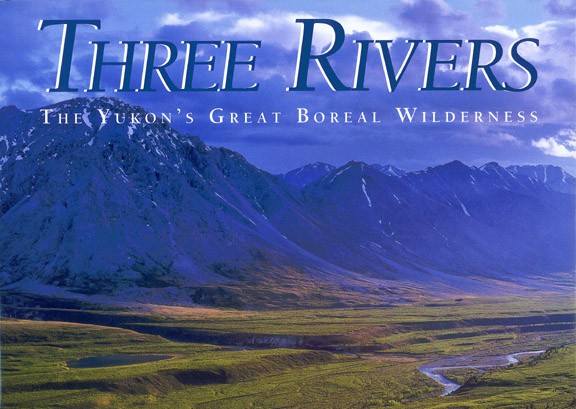
I often come across Estonians in seemingly unlikely places. I say seemingly because once I enter into conversation with one of them, I discover a perfectly Esto sensibility to their choices about where to live and what to do with their lives. Often they are living rich and fascinating lives and, when asked, link their activities to their families and culture of origin. Frequently, they live far from other Estonians and have little interaction with things Esto other than themselves. Juri Peepre is a case in point. When I discovered his name as one of the editors (with Sarah Locke) of the new book, “Three Rivers: The Yukon’s Great Boreal Wilderness,” my curiosity was sparked.
First of all, Three Rivers is beautiful coffee table style book, laden with magnificent wilderness photographs. The accompanying text is a series of essays about three of the rivers of the Peel watershed in the Yukon: the Snake River, the Bonnet Plume River and the Wind River. Literary luminaries such as Margaret Atwood and John Ralston Saul and reknown photographers such as Courtney Milne as well as lesser known writers, photographers and artists give breath and depth to the reader’s experience of this remote and wild region. I enjoyed the diversity of voices and perspectives the work presented, especially the ones that narrated the adventures of the three groups of artists and activists who canoed and rafted, one each, down the three rivers in question.
But still the question persisted: who is Juri Peepre and how did he end up being an environmental activist in the Yukon? I read the sections he wrote attentively and looked up the authorship of each photograph to see which ones were taken by him. Of the stunning mountain, river and wildlife photos in the book, the moodiest ones were Juri’s. Often taken at dawn or dusk, they evoke a mystery and allude to that which cannot be seen, only felt. His writing, on the other hand, is concise and to the point in its intent to inspire readers to take action to protect this precious wilderness. Armed with contact info from the publisher (Harbour), I got in touch with Juri.
Juri Peepre was born in 1952 in Guelph, Ontario and had a somewhat typical southern Ontario, Esto life. Estonian was the language of home, and he spent time at Seedrioru and in Estonian Boy Scouts. At university (Guelph) he studied Landscape Architecture. With all nicely in place to become an urban professional, Juri jumped the rails at graduation, heading west and north to fulfill his longing for wilder places. After a few years living in Calgary and Vancouver but canoe tripping extensively in the Northwest Territory, he and his partner, Sarah Locke, jumped on the opportunity to live and work in the Yukon. They’ve been there ever since – 20 years. There, he worked as the Yukon Executive Director of the Canadian Parks and Wilderness Society (CPAWS) until 2004 and wrote numerous essays on the Yukon environment for various books.
When I asked him whether this passion for nature was tied to his Estonianess, he answered, “my father was key.” His father, Alexander Peepre, was an accomplished woodsman who was a youth and sports instructor already in Estonia, leading children’s camps at Kadrioru Park. During the war, with the Soomepoisid, he was known for his orientation skills in leading troops out from behind enemy lines. When his parents arrived in Canada, they got into camping, Ontario style and Juri spent every summer in Algonquin Park where his father taught nature programs and his mother worked as a camp cook. “The magic my father experienced as a child in Eesti was translated into this context. He could enter a farmer’s woodlot and make the forest come alive like wilderness,” Juri says of his father. “My mother too, has a great love of nature,” he added. “Is that Estonianess? I don’t know.”
Speaking about the first time he went to Estonia in 1987, Juri noted that he was surprised to discover the local forest and farmer’s fields that have been harvested sustainably for a thousand years and local berry patches that have been in families for generations. He realized that Estonian culture is a “farm culture tied to the land.” Of his most recent visit to Estonia, he noted that he was very impressed with the network of protected areas that the government has established over the past 15 years. “It seems like after 50 years of Soviet times, nature is being rediscovered in Eesti, even if it is primarily by urban folks in Mercedes Benzes.”
So what is he up to now? Juri continues to work on the Three Rivers project whose aim is to have this Yukon region protected for its wilderness values. He is currently organizing venues for the Three Rivers Art Show which came out of the river trips described in the book. In the spring of 2007, he’ll be touring Canadian cities with his slide show and talk. For information about tour locations and dates, please visit www.cpawsyukon.org. (The book can also be ordered through this website at the CPAWS-online store.)
When I suggested Tartu College as a possible Toronto venue, Juri chuckled at the prospect of doing his lecture in Estonian. “I only ever speak Estonian with my relatives,” he said, but was willing to give it a try when I told him about the kind audience who supplied me with vocabulary during my own book presentation at Tartu College last January (Tartu College organizers take note!). In the future, when the Three Rivers project comes to a close, Juri hopes to continue communicating about the north, its wilderness and beauty, its people and their dreams. What an Estonian thing to do!
(Three Rivers is also available in quality bookstores across Canada. All net proceeds will go to efforts to protect wilderness in the Yukon for future generations to enjoy.)


















